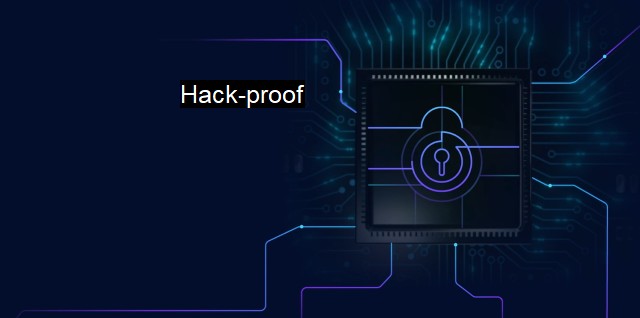What is Hack-proof?
Exploring the Concept of Hack-Proof: Evaluating Innovative Cybersecurity and Antivirus Measures.
"Hack-proof" is a term widely used in the domain of cybersecurity and antivirus that denotes a system, network, or software free from instances of unauthorized access or intrusion. When a platform or technology is labeled as "hack-proof," it intends to communicate that the data therein is designed to repel hacking attempts. it's necessary to remember that the concept of a completely hack-proof system is conventionally contestable and largely theoretical in the continually evolving landscape of cybersecurity.The emphasis on making systems "hack-proof" springs from the steady rise in cybercrime incidents. In multiple industries and sectors like e-commerce, banking, corporate businesses, and governmental institutions, unauthorized breaking into databases to exploit sensitive data has become worryingly recurrent. Stealing private data, including personal identities and financial information, is among the most common intent of hackers seeking access to an organization's system.
Therefore, cybersecurity has emerged as an indispensable component for any organization, irrespective of its size or function. Firms invest millions in cutting-edge software and technology to assure their information assets against threats. These measures are designed to monitor, prevent, and control unauthorized access, making the corresponding system or network "hack-proof".
Antivirus software plays a fundamental role in cybersecurity strategies and their endeavor in making systems "hack-proof". The programming of an antivirus, from its basic definitions to its more complex qualities, serves to safeguard the system from numerous types of intrusion, including software vulnerabilities, malware, phishing attacks, ransomware, and more. The antivirus identifies these threats and impedes their actions, serving an essential function in protecting the information stored and transferred within systems.
Advancements in technology and the antivirus industry have boosted the efficiency of these protective measures. Technologies such as Artificial Intelligence and Machine Learning are now bundled within todays' antivirus solutions, striving towards "hack-proofing." The integration of continual innovation and developments helps cybersecurity setups maintain pace with hackers' rapidly evolving tactics.
While having numerous layers of proactive barriers to counteract hacking attempts, it's essential to remember that achieving an entirely hack-proof architecture might not be possible in a digital world where threat vectors continually change and evolve. Many security alliances and policy-making bodies argue that while mitigating risks is achievable, completely eliminating them might not be realistic due to technology's continuous progression and persistent human error.
Hackers continuously try to exploit every technological advancement, rapidly changing their methods to infiltrate unsuspecting systems. Breached security mechanisms often leave behind vulnerabilities that are notoriously difficult to detect, masking their presence entirely from the system administrator. Heightened defenses and increasingly advanced security protocols can minimize the probability of successful hacking; eliminating the possibility to nil might not be fully practical.
Regardless of the practicality of implementing a system that is 100% hack-proof, the continuous effort to prevent unauthorized access drives the cybersecurity and antivirus industry to innovate. Today, developers are striving to produce software that is resilient to almost all known hacking attempts under the ever-changing threat landscape.
It's imperative not to presume anything to be completely "hack-proof"; rather, the endeavor should always be to 'be secure'. Despite inherent threats, placing trust in professionally designed security measures, regular software update, user awareness, and safety protocol education will help maintain a precautionary and resilient stance that cybercriminals find complicated to challenge.
The term "hack-proof" represents the pinnacle of cybersecurity, an ideal safeguard to identity theft, data misappropriation, and financial falsification. While it may appear unattainable, it remains the common goal of everybody involved antivirus software development, or data protection. the pursuit of creating a "hack-proof" system might not entirely eradicate risk, and vigilance must always be practiced to reduce vulnerabilities and maintain the ceaseless evolution of security in the digital realm.

Hack-proof FAQs
What does "hack-proof" mean?
"Hack-proof" is a term used in cybersecurity to describe a system or software that is highly resistant to hacking attempts. It implies that the system has been designed and implemented with a high degree of security measures to prevent any unauthorized access.Is it possible to have a system that is completely hack-proof?
It's not possible to have a system that is completely hack-proof since hackers are constantly looking for vulnerabilities to exploit. However, it is possible to build a system with strong security measures that make it extremely difficult and time-consuming for hackers to break into.What are some examples of hack-proof software or systems?
There are no software or systems that are completely hack-proof, but there are some that are highly secure and resistant to hacking attempts. Examples include antivirus software, firewalls, and encryption software.What can I do to protect my computer from hackers?
To protect your computer from hackers, you should install reputable antivirus software, keep your software up-to-date, use strong and unique passwords, avoid clicking on suspicious links or downloading unknown files, and regularly backup your data. It's also important to be mindful of phishing scams and to use caution when using public Wi-Fi networks.| | A | | | B | | | C | | | D | | | E | | | F | | | G | | | H | | | I | | | J | | | K | | | L | | | M | |
| | N | | | O | | | P | | | Q | | | R | | | S | | | T | | | U | | | V | | | W | | | X | | | Y | | | Z | |
| | 1 | | | 2 | | | 3 | | | 4 | | | 7 | | | 8 | | |||||||